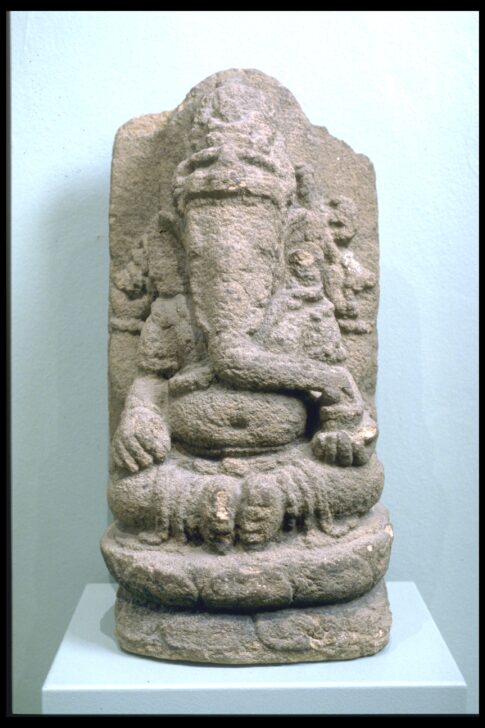Ganesha, seated on a double lotus throne
Indonesian

Description
March 28, 2009
Pot-bellied Ganesha, with his elephant head and curved trunk, is perhaps the most endearing and gentle of the Hindu gods. The elder son of Shiva and Parvati, he is famed for removing obstacles; as such, he is worshipped at the start of any new venture. Scribes, for instance, will inscribe Ganesha’s name before writing anything else, as will students beginning an exam. His presence is also invoked at the onset of religious rituals. Sculptures of the plump god are typically located near the entrance to Hindu temples so that they are among the first encountered in the act of circumambulation. Also, when sweets are prepared for a festival day, the very first portion will be set aside in his name. This stone sculpture from eastern Java suggests that the treats do not go to waste: Ganesha’s trunk drops directly into a bowl of snacks that rests in his left hand.
(Label for UMMA South and Southeast Asia Gallery Opening Rotation, March 2009)
Subject Matter:
Ganesha, the elephant-headed Hindu deity who removes obstacles.
Pot-bellied Ganesha, with his elephant head and curved trunk, is perhaps the most endearing and gentle of the Hindu gods. The elder son of Shiva and Parvati, he is famed for removing obstacles; as such, he is worshipped at the start of any new venture. Scribes, for instance, will inscribe Ganesha’s name before writing anything else, as will students beginning an exam. His presence is also invoked at the onset of religious rituals. Sculptures of the plump god are typically located near the entrance to Hindu temples so that they are among the first encountered in the act of circumambulation. Also, when sweets are prepared for a festival day, the very first portion will be set aside in his name. This stone sculpture from eastern Java suggests that the treats do not go to waste: Ganesha’s trunk drops directly into a bowl of snacks that rests in his left hand.
Physical Description:
Ganesha is shown here seated on a double lotus throne, in a royal posture with the soles of his feet together. He has four arms, and holds two of his attributes in the rear pair: an ax and a rosary. His trunk curls down across his rotund belly to reach for a bowl of sweets that rests in his left forward arm. The cobra slung across his shoulder, now hard to make out because of the centuries of wear of the stone, indicates Ganesha's lineage as the son of the Shiva, in his aspect as the great ascetic. Almost 27 inches high, this sculpture of the Hindu god Ganesha is carved of andesite, a volcanic stone common to the island of Java in Indonesia. Andesite is a soft stone and erodes easily, which is why the carving is no longer crisp.
Usage Rights:
If you are interested in using an image for a publication, please visit https://umma.umich.edu/request-image/ for more information and to fill out the online Image Rights and Reproductions Request Form.